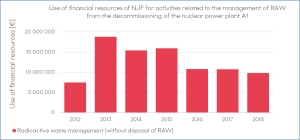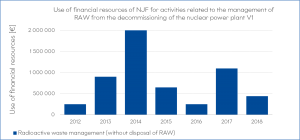MANAGEMENT OF RADIOACTIVE WASTE
MANAGEMENT OF RADIOACTIVE WASTE IN GENERAL
Different types of waste are generated in operation as well as during the decommissioning process of nuclear installations. This scope includes categories from municipal waste up to higher activity waste, which requires further management. Management of radioactive waste (RAW) refers to collection, classification, storage, treatment, conditioning, handling and disposal thereof.
In comparison to the waste generated during operation, a larger amount of solid radioactive waste related to dismantling and demolition is generated during decommissioning. The National Nuclear Fund secures financing of the management of radioactive waste arising from the decommissioning process. The management of RAW arising from the operation of nuclear power plants is reimbursed by the licence holder for the operation of a nuclear installation.
The first step in the process of RAW decommissioning is its collection and classification based on its subsequent treatment and conditioning. In case of decommissioning of the nuclear power plant A1, operational solid waste was not separated. This fact complicated its retrieval for further treatment and conditioning.
The primary purpose of RAW treatment is to increase safety in further stages of its management as well as to improve technical and economic parameters with regard to its conditioning and disposal. This can be achieved in different ways such as separation of radionuclides from waste, change in RAW composition and its volume reduction.
After the treatment process, the radioactive waste is conditioned into a solid form suitable for transport, disposal or potential storage. During the conditioning process, in most cases, the waste is appropriately solidified (by cementation, vitrification, fixation in aluminum-silicate polymeric matrix – so-called SIAL matrix) and inserted into a packaged form – e.g. into a steel cask and subsequently into a fibre-reinforced concrete container.
Storage of RAW refers to its interim siting in suitable premises and facility. On the contrary, RAW disposal refers to its siting into a repository without the intention of its subsequent retrieval and handling. Hence, disposal is the final step in the process of RAW management.
COSTS FOR MANAGEMENT OF RAW FROM DECOMMISSIONING OF NUCLEAR POWER PLANTS A1 AND V1
Financial resources related to the management of radioactive waste from decommissioning of the nuclear power plants A1 and V1 represent part of total financial resources spent for decommissioning of these nuclear installations. Financial resources of the National Nuclear Fund related to the management of radioactive waste (with the exception of disposal of radioactive waste in the National RAW Repository in Mochovce) are provided from analytical accounts of the nuclear power plant A1 and the nuclear power plant V1. In the case of the nuclear power plant V1, part of costs for the management of radioactive waste from decommissioning is reimbursed through EU resources from the Bohunice International Decommissioning Support Fund for V1. In the case of the nuclear power plant A1, the costs for the management of radioactive waste from decommissioning are fully reimbursed from resources of the National Nuclear Fund, namely from the levies intended for the coverage of the historical debt.



